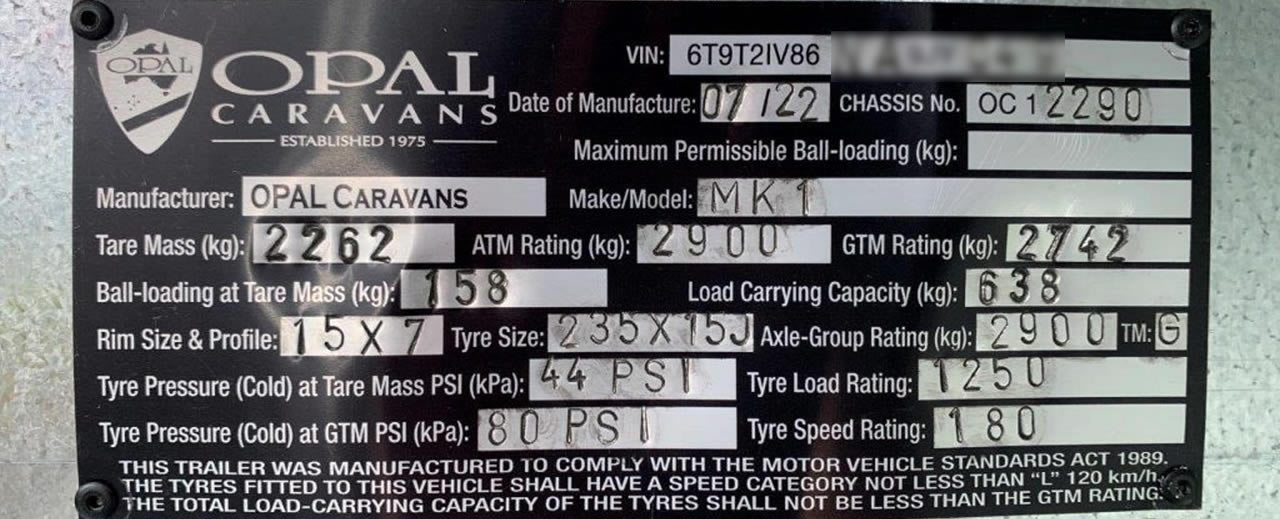Understanding Your Caravan Compliance Plate
What is a caravan compliance plate and what do the numbers and other things listed on it mean? They all mean something and can often be confusing if you don’t know what you are looking at.
Locating Your Caravan Compliance Plate
The first thing you need to do is find where it is. Common locations are on the drawbar, in the tunnel boot, in the front boot or just inside the entry door. Once you find yours take a photo of it and have a read.
It became law in 1989 for ALL vehicles including home built trailers to have a compliance plate fitted. If your caravan was built before 1989 then chances are it may not have one fitted.
If your caravan doesn’t have a compliance plate fitted and it was built after 1989 the first thing you should do is contact the manufacturer and talk to them. Possibilities are it was overlooked and not fitted or it has been removed by a previous owner. Personally if I was looking to purchase a used caravan and I couldn’t find the compliance plate I would save myself a potential headache move on to looking at something else. Not having a compliance plate fitted will make it difficult to prove that the caravan is the one listed on the registration papers.

Caravan Compliance Plate
Things Commonly Listed On a Caravan Compliance Plate
Manufacturer
The name of the manufacturer of the caravan
Make/Model
The model of the caravan as built by the manufacturer.
VIN Number
This is a unique number belonging to this vehicle used by RMS and/or police to identify the caravan – check registration is current etc. Your caravan insurance company will also want to know the VIN Number. The VIN number will often also be welded on to or etched in to the chassis usually on the drawbar as confirmation.
Date of Manufacture
The date the caravan was made
Tare Mass
The weight of the caravan as manufactured. It doesn’t include extras ordered after manufacture or added to the caravan by the dealership. It won’t include include gas (sometimes even the bottles) or water in your caravans water tanks. A lot of caravans being made by major manufacturers are weighed when manufactured. It doesn’t appear that there is any legal obligation for them to do so as they can calculate it based on build specifications. If a manufacturer hasn’t weighed your caravan when applying the compliance plate then there is a possibility that your caravan may be heavier when empty than you thought. It’s probably a good idea to call in at a public weighbridge on your way home from picking up your caravan and checking it out.
ATM Rating
Maximum allowable weight of the caravan when not hitched to a vehicle
GTM Rating
Maximum allowable weight of the caravan whilst hitched to the tow vehicle. For more information on GTM, ATM read Caravan Weights Explained.
Axle Group Rating
Maximum allowable weight specified by the axle manufacturer. this is often higher than the GTM or ATM Rating (but should never be lower).
Ball Loading at TARE
Ball loading at TARE can be mistaken as a ball weight recommendation however this is not the case. Ball Loading at TARE is meant to be the ball weight of the caravan as manufactured. Taken when empty it is often misleading as the ball weight will change as soon as you load anything in to the caravan.
Maximum Permissible Ball Loading
The maximum allowable weight the tow ball weight can be when the caravan is fully loaded.
Tyres
Instead of asking your question about what is the recommended tyre pressure, size or type for caravan maybe a look at your caravan compliance plate would be a better starting point.
- Rim Size and Profile
- Tyre Size
- Tyre Pressure cold at TARE
- Tyre Pressure cold at GTM
- Tyre Speed Rating
If you have any questions about tyre pressures don’t take my recommendation or the internets recommendation. Instead go to your your local tyre dealer.
Chassis Plate
The chassis plate is NOT the caravan compliance plate. Often a caravans chassis will have been built by a third party and they supply caravan chassis to many different caravan manufacturers. The chassis builder will often rate the chassis to a certain weight. This can be more than the GTM or ATM. Under no circumstances does it mean you can legally load your caravan to this weight.
